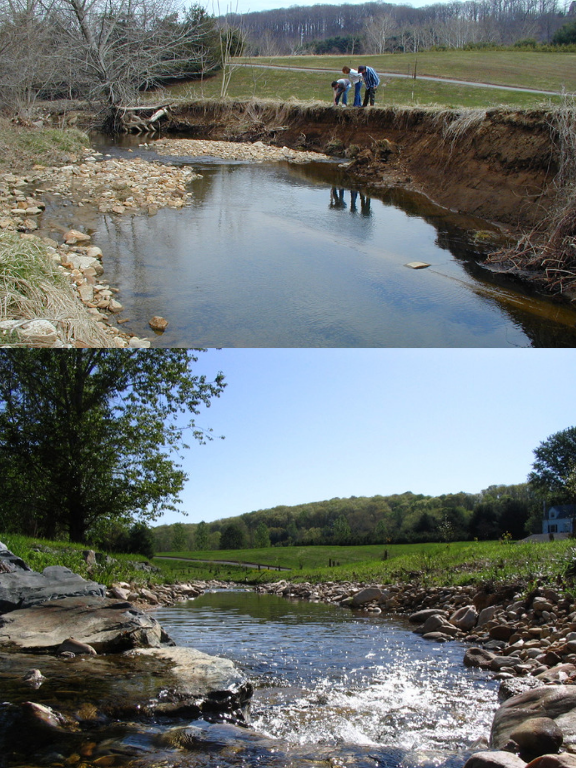EPA Stream Restoration Research Supports Chesapeake Bay Recovery
Published June 4, 2019

Fifty-one billion gallons. That’s the average amount of water flowing into Chesapeake Bay on a daily basis. And as all that water seeps, flows, and cascades across the watershed before it spills out into the Bay—the nation’s largest estuary—it picks up signature characteristics of where it has been.
Flowing across pavement-dominated urban and suburban landscapes and routed into highly engineered stormwater infrastructure systems, runoff might pick up any number of contaminants, including motor oil and lawn fertilizers. Agricultural areas can contribute excess nutrients and eroded sediments.
Natural habitats—forests, wetlands, grasslands—act as a kind of collective filter for the watershed. For example, free-flowing streams flanked by forests and filled with the occasional downed tree provide microhabitats flush with the kind of plants, fungi, and bacteria known to absorb pollutants and convert reactive nitrogen into less harmful forms.
Municipalities across the Chesapeake Bay watershed and elsewhere have taken note, sparking efforts to restore local streams to a more natural-like state. Typically, such efforts are led by ecological and environmental engineers who work with landscape architects to add physical and biological elements to degraded streams.
Projects range from adding a few structural elements such as large boulders and tree trunks, to full-scale landscaping operations that include dredging away “legacy sediments” (soil and other debris eroded from uplands over the past several centuries) and re-grading stretches to vary stream flow.
While stream restorations are often popular with local communities due to their ability to stabilize banks, reduce erosion, and improve aesthetics, they have also become increasingly attractive as part of larger strategies to meet water quality standards. As such, it’s critical to know just how much they can contribute to collective efforts across the watershed to restore and protect Chesapeake Bay.
EPA researchers are helping. They and their partners are applying rigorous scientific methods to quantify the effects and benefits of stream restoration. In a foundational study, agency researchers and their collaborators explored the current literature of stream restoration studies to develop a typology of approaches and analyze their impacts on nutrient retention. The work now provides important insight for those planning restoration project as well as the need for additional, long-term studies to inform future progress.
EPA ecologist Paul Mayer has been conducting some of the longest running studies of stream restoration to date, much of it within the Chesapeake Bay watershed. He and his partners are particularly interested in assessing and monitoring levels of key pollutants before and after restoration, including reactive nitrogen and phosphorous. Mayer also serves on an expert panel assembled by the Chesapeake Stormwater Network to update and adjust the protocol to define nutrient removal rates for stream restoration projects.
“Our collective research is designed to assess the effectiveness of stream restoration for improving the ability of streams and riparian zones to process nitrogen and phosphorus where excess amounts of these nutrients can be an example of ‘too much of a good thing’—the end result of which can be the contamination of drinking water or other undesired responses such as eutrophication or dead zones in the Chesapeake Bay,” explains Mayer.
In one recently published study, Mayer and co-authors explored the effectiveness of a technique called regenerative stormwater conveyance (RSC for short) that triggers filtration by routing stream flow over a series of shallow pools lined with substrates of permeable sand overlying a mixture of organic materials such as wood chips. Field studies were conducted at two restoration sites on tributaries of the Severn River, which flows to Chesapeake Bay. That work was supplemented by laboratory studies simulating the techniques used in the streams.
Despite the fact that regenerative stormwater conveyance has been used for just over a decade, this was the first study known to combine different field studies with laboratory analysis. The researchers were able to carefully compare and contrast different conditions and substrates, such as varying the type and composition of sand mixtures.
What they found is that regenerative stormwater conveyance can be an important choice for stormwater management and a best management practice for nutrient reduction—but does not offer a one-size-fits-all approach across the watershed.
“RSCs are generally effective but some aspects can have negative water quality tradeoffs that engineers/designers should note and strive to minimize in their designs,” the researchers conclude. An important finding is that there may be tradeoffs in managing nitrogen versus phosphorous because variations to the RSC approach may improve nitrogen retention while mobilizing phosphorous. So, managers need to carefully select restoration approaches and implement where most effective without causing any additional negative impacts. The emerging research can help them adjust accordingly.
Such results illustrate how EPA science is advancing stream restoration. The overall aim is to eventually provide the research needed to answer site-specific questions that can guide environmental managers, such as: “What is the most cost-effective technique for this site?” And “How does time impact the benefits of my prescribed stream restoration?” The agency and its partners across the watershed will to continue to seek answers that help them protect and restore the nation’s largest estuary. With 51 billion gallons of water flowing into Chesapeake Bay every day, that’s a lot of opportunity to learn—and to improve water quality along the way.
Sources and Citations
Berg, J., Burch, J., Cappuccitti, D., Filoso, S., Fraley-McNeal, L., Goerman, D., ... & Kerr, B. (2013). Recommendations of the Expert Panel to Define Removal Rates for Individual Stream Restoration Projects FINAL DRAFT.
Duan, S., Mayer, P. M., Kaushal, S. S., Wessel, B. M., & Johnson, T. (2019). Regenerative stormwater conveyance (RSC) for reducing nutrients in urban stormwater runoff depends upon carbon quantity and quality. Science of The Total Environment, 652, 134-146.
Newcomer Johnson, T., Kaushal, S., Mayer, P., Smith, R., & Sivirichi, G. (2016). Nutrient retention in restored streams and rivers: A global review and synthesis. Water, 8(4), 116.
